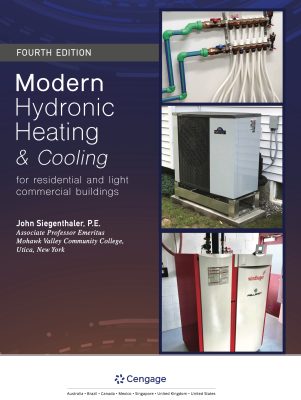That I can get excited about compression tanks probably means that I’d be a lousy lunch companion, right?
I mean who wants to hear about solving problems with something that hangs from the ceiling or from that pipe over there when we could be scarfing down burgers and fries and staring at our smartphones instead?
But trust me; there’s a great story here. Even the name we give these things has a story behind it. We didn’t start calling them compression tanks until around 1915 when this plain-vanilla hydronic component moved from lofty attic to lowly basement. Those attic tanks were things of beauty. Many were made of copper, which makes them quite popular with modern mongo men. They also were open to the atmosphere. The Dead Men called them expansion tanks because the tank was the place where the water expanded. And if it expanded too much, the water just spilled out onto the roof. Such an elegant solution!
But it was cold in those attics and that was a problem. When the water in the tank froze, the water in the rest of the system would have no room for expansion and that would make a mess in the basement where the relief valve stood watch. This was, of course, embarrassing to the heating professional.
So they moved the tank to the basement and sealed it. Now that it was closed, the air had a place to get squeezed as the water heated. That was important because you can’t squeeze water. Well, you can try, but you’ll just get wet.
How’s that burger?
Those old-school tanks hung from the basement ceiling. They contained no diaphragms because Amtrol didn’t yet exist. They’re as basic as it gets. The larger ones have gauge glasses so we can see the water level inside the tank. But that gauge glass brings its own problems to the table. If the system is losing air from the tank, I suggest you give that gauge glass the stink-eye because, according to the folks who make them, you’re supposed to keep the valves closed unless you’re checking the water level inside the tank.
Did you know that?
Those valves have packing glands and the upper valve sits in air, not water. Its valve-stem packing always will be dry and if the valve is always open, the air in the tank will creep out through the dry packing and leave the system. That’s because high pressure goes to low pressure. Always.
And as the air leaves, the system pressure drops. Someone will add water to the system (or a feed valve will do the job automatically) and the water will go into the only place it can go, that being the tank. The water level inside the tank rises; the stem packing gets wet and you never see a leak.
Some guy scratches his head. Where’d the air go?
The system water gets hot and expands, but with the now-diminished air cushion inside the tank, the expanding water has hardly anywhere to go. So the pressure builds and the relief valve pops, splashing hot water all over the boiler room.
Isn’t this better than checking Facebook? Thanks for not posting a photo of your burger. You gonna eat those fries?
Keep it closed
Anyway, this is why heating professionals always should keep the valves on the gauge glass closed. The only reason to open them is if you need to check the water level. But they get left open all the time because people are too lazy to get a ladder when it’s time to check the water level inside that tank.
So here’s what I suggest: If someone keeps opening those valves, you should close them, get a hammer and break the glass. If they fix the glass and open the valves again, you break the glass again. You can break it faster than they can fix it. Sooner or later you’ll wear them down.
Please pass the ketchup.
If an old-school tank is losing its air and doesn’t have a gauge glass, get some soapy water and check for pinholes in the top of the tank. Look, too, at how the tank connects to the system. There should be a Bell & Gossett Airtrol tank fitting at the bottom of every old-school compression tank.
This device, which has been around longer than old Gus over there at the cash register, stops gravity circulation between the tank and the system piping. The cooler water in the tank will absorb the tank’s air charge. This is Henry’s Law at work. If there’s gravity circulation in the line connecting the tank to the system piping, the cooler water with the dissolved air will fall into the system piping and enter the flow of hot water. The cooler water that left the tank will get hot and give up the air it carried from the tank, and that air will wind up in a radiator.
Someone will bleed the radiator; the system pressure will drop. Fresh water will enter the system and go straight into the tank. Now there’s not enough room for expansion of the hot water, so once again the relief valve pops.
Need more napkins?
You can have as many compression tanks as you’d like on a hydronic system, but you have to connect them all to a manifold and then connect the manifold to the system piping at a single point. This becomes the point of no pressure change for the circulators. If you have multiple points of no pressure change in a hydronic system, the circulators will get very confused and start doing some wacky things with their pressure differential, which can cause system problems.
And how about this? If an old-school tank is losing its air and everything else looks good, go find that big radiator that’s filled with air. That radiator is acting like a second compression tank and a second point of no pressure change. It sets up a condition for the circulators where they establish a point of no pressure change somewhere between the tank and the air-bound radiator. Water leaves one “tank” and enters the other “tank.” The result is usually an old-school tank that just can’t seem to hold its air.
Delicious, right?
If you’re using more modern compression tanks, the sort that have diaphragms, know that a diaphragm is a semipermeable membrane and that the air that’s supposedly trapped behind the diaphragm forevermore really isn’t. Air will move right though that rubber membrane by osmosis and at an average rate of 1 psi per year. The air winds up in a radiator and someone will vent it. Fresh water enters the system and the relief valve pops because there’s not enough air on the other side of the diaphragm to allow for the expansion of the heated water.
Amtrol invented the Extrol tank. Its original tanks used dry ice for the air cushion. Amtrol figured the trapped carbon dioxide that formed when the dry ice evaporated would stay put. But then the company learned it doesn’t. It moves across the diaphragm by osmosis. That’s why Amtrol switched to a Schrader valve as a solution. Take the water pressure off the tank before you check the air pressure, though, or you’ll get a false reading.
Tank manufacturers don’t broadcast that business about the migrating air, but if you ask them, they’ll tell you it’s true. Tanks lose at least 1 psi of air pressure every year, at the very least.
If you don’t know that, you’ll be reaching for the Tums.
No, I got this. I insist. This one’s on me.
This article was originally titled “Burgers and tanks” in the May 2016 print edition of Supply House Times.








